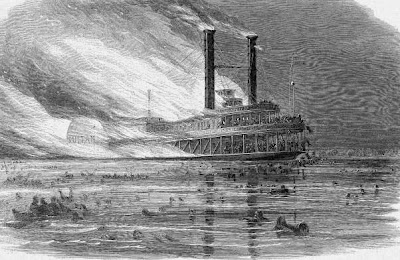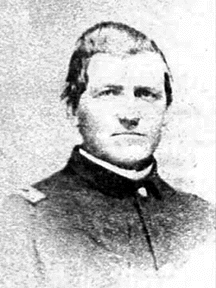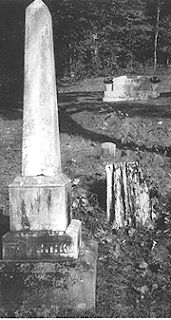
When the Civil War began, George Washington Ward, despite his tender age of 15, bid his family good-bye, and went to Ohio, to work in a furnace near Hanging Rock, Lawrence Co. Ohio. Ward stated, "Being a Union boy in sentiment I could not live at home and went to Ohio and remained there until I was old enough to enlist. In the summer of 1863 I returned home and entered the US service."
He enrolled as private in Co. G, 14th KY on August 5, 1863 under the name Washington Ward and was mustered into the service on August 30, 1863 at Louisa, KY. He was 5' 9 1/2" tall, had red hair and blue eyes.
On July 1, 1864, near Atlanta, Ward contracted diarrhea, due to excessive hardships and exposures, and was subsquently treated in hospitals at Marietta, Georgia, Knoxville, Tennessee, and Louisville, Kentucky.
He was later transferred to the 14th KY Battalion, Co. D with the other 14th KY recruits and re-enlisted veterans. George Washington Ward was finally discharged from the service on September 15, 1865 at Louisville, KY. He returned home from the war in broken down physical condition, due to the chronic diarrhea he had contracted during the Atlanta Campaign in 1864. He remained at home for about six months, during which time he was cared for by Adam Crum, a childhood friend.
In spring of 1866, George Washington Ward moved to Burlington, Ohio, where he remained until 1867.
After a short visit at home, with additional chronic diarrhea attacks and attended once again by Adam Crum, he moved to Seymour, Indiana in 1868 where he lived until the spring of 1869, and then removed to Paoli, Kansas. Here he had contact with his former Captain of Company G, John C. Collins, who also resided in Paoli. After a year George Washington Ward moved to Wichita, Kansas but the "call of the West" was too strong for him. In 1873, he entered the town of Trinidad, Colorado, where he began working as a cook in one of the local hotels. During the same year, he met a German by the name of Charles Tamme who was to become Ward's life-long close friend.
Tamme was born in Braunschweig, or Brunswick, Germany, in 1844. As he was growing up he became interested in the American West. In 1865, he immigrated to the United States and after a brief stay in Pennsylvania as a store clerk, Tamme headed West where he pursued an adventurous life, which included three life-threatening attacks, once by a bear and twice by Indians, earning a living as a freighter and a farmer.
According to Tamme, Ward was thin and lank and looked very much like he had a consumption when they met in Trinidad in 1873. For the next ten years, between 1873 and 1883, both men usually roomed and boarded at the same places and both being single men and "Chums", as Tamme described it, he usually waited on his friend and took care of him whenever he had a severe attack of bowel trouble. According to New Mexico Governor Miguel A. Otero Jr., who made Tamme's acquaintance later in life, wrote of him that, "he was as gentle and kind as a woman and honest as the day is long."
Ward's chronic diarrhea did not seem to improve much and he continued to suffer from attacks every six to ten weeks. He was treated first by a Dr. Allen and later by Dr. Charles C. Gordon.
1878 saw the advent of the Atchison, Topeka and Santa Fe Railroad. Both Ward and Tamme decided to follow the railroad from Trinidad to the Territory of New Mexico. They settled in East Las Vegas [later Las Vegas] in 1879 and lived at 334 Railroad Avenue by 1883. Soon the two men went into business together and opened the later popular "Monarch Billiard Hall".
The climate in New Mexico seemed to agree with Ward and his diarrhea attacks lessened to a degree. In 1881, Ward's former doctor, Charles C. Gordon, had moved from Trinidad to Las Vegas, ran into Ward and treated him once again for diarrhea, stating that it was "not as severe" as it had been in Colorado.
By 1885, Gordon was Surgeon-in-Chief of the Hospital near Las Vegas.
A second doctor who treated George Washington Ward was Myron W. Robbins, former surgeon of the 4th Iowa Infantry, who met Ward in 1880 and began treating him in 1882 for intestinal catarrh. According to Robbins, Ward suffered from two to four attacks per year, lasting from four to ten days. He stated that" Ward has to be at all times careful of his diet and exposure to cold to enjoy moderate degree of health."
Meanwhile, Ward and Tamme began pursuing another business venture. In 1882, the editor of the "Daily Optic", a local Las Vegas newspaper, published a challenge to the community, for someone to establish an opera house. Ward and Tamme felt up to the job and with the help of Tamme's friend James M. Hamilton, a shoe merchant of St. Louis, they constructed the "Ward & Tamme Opera House" which was later sold in 1893 after Tamme had constructed a larger Opera House on Douglas Avenue in 1886.
In 1883, Charles Tamme married. Ward and his friend remained close, nevertheless. It may have been the event of Tamme's marriage that triggered thoughts of his family back in Eastern Kentucky in George Washington Ward's mind. According to Asa Williamson, another childhood friend from Martin County, KY, Ward had payed visits to his parents on at least two different occasions by 1886.
On June 8, 1885, Ward applied for a pension, based on his chronic diarrhea which he had contracted in the service during the Civil War. His pension was approved at a rate of $2 per month.
Meanwhile, George W. Ward appeared several times in the local newspapers. He took an interest in baseball and traveled to Albuquerque in 1887 to enjoy a few baseball games. In July 1888, Ward drew a winning ticket in the Louisiana State Lottery. In January 1889, Ward partook in a possum dinner as the result of a bet. The oppossums were secured from Kansas City and the local paper noted that "this southern dish will be served in due time with all the necessary adjuncts."
In 1890, George Washington Ward served as town marshall of Las Vegas. Dr. Geo. M. Kellog, who examined him on June 30, 1891, described Ward as a man "of very large habit. Chest measurements above nipples 43 inches, full inspiration 45 inches." He also noted that Ward "has nervous tremors in hands, is strictly temperate and well-known in town."
Based on Dr. Kellog's examination, George Washington Ward received an increase in his pension to $12 per month, to date from June 21, 1891, for chronic diarrhea, dyspepsia and disease of heart.
In 1893, the New Mexico Insane Asylum was established in Las Vegas, a facility that housed 250 patients. George Washington Ward was appointed superintendent, a position he held until his death in 1913. According to local records, Ward "believed in the usefulness of these needy people and envisioned a garden for them to work in. Nineteen acres of a barren grounds were developed by the patients into wonderfully terraced flower and vegetable gardens, which saved the Territory $3,378.69 in 1898."
In 1896, the "New Mexican" hailed Ward as "the right man in the right place, and his services have been invaluable."
During the same year, in autumn of 1893, Special Examiner E. S. D. Patron from the United States Pension Board arrived in Las Vegas and established his headquarters in town. In a deposition he stated, "When I first took up headquarters here last Autumn many of the best citizens here came to me and complained of what they termed the "fraud" the pensioner [G. W. Ward] was perpetrating on the Government in drawing a pension, and since that time I have observed pensioner closely whenever circumstances permitted. He is a very examplary man, the picture of health and one of the finest specimens of physical manhood I have ever seen. He is a bachelor, a large property holder, and besides is the Steward of the New Mex. Insane Asylum, having been well fixed financially for several years, besides holding lucrative positions to which no manual labor was attached; there has been no necessity for his doing any hard works; although during the time I have known him he has been able to attend to business every day, and from his general appearance and the action manner in which he gets around, it is my opinion that he is fully able to perform any kind of manual labor if necessity requires him to do so."
Patron insisted on a thorough medical examination of Ward by Dr. W. Morgan of the Board of Office Surgeons which took place on August 10, 1894.
Morgan stated that George Washington Ward, "is a fine specimen of physical manhood. Nurtition excellent. His face is ruddy with the glow of health - no congestion of the ports. Complexion florid - Hair & Eyebrows light in color. He is a perfect picture of good health which does not only shows itself in excellent nutrition & healthy complexion but in the bright happy expression of countenance.
Skin healthy, teeth well preserved. Ward said that he has had no trouble with his bowels since last summer. He has had better health this summer + last Winter than for several years prior. He is not a hypochondriac. Looks like he enjoyed good health + that he is glad to be alive. He is Hospital Steward at the State Insane Asylum and seems to be "a right jolly good fellow"."
After this glowing medical review, Patron wrote that, "from Dr. Morgan's examination and my general lay knowledge of the state of pensoner's health for the past year, I am convinced that he has not the slightest right to a pension, and I respectfully recommend that his name be dropped from the rolls".
Accordingly, Ward's pension was discontinued.
On February 4, 1895, George Washington Ward once again began receiving a pension, at a rate of $2 per month which was increased on March 2, 1895, to $ $6.
In June 1899, George W. Ward was once again in the public eye when Teddy Roosevelt and his Rough Riders arrved in Las Vegas on their way home. A "Rough Riders and Citizens" parade was held in which one of the divisions was led by George W. Ward, "accompanied by the Chihuahua band."
On October 16, 1899, Ward asked for an increase of his pension. After almost four years, on June 24, 1903, the Pension Board ruled that Ward was not entitled to restoration to former rate from date of dropping in 1899, but was approved for renewal, at the old rate of $6 per month. His claim, however, was not approved on his claim of chronic diarrhea but, ironically, for obesity.
George Washington's weight had been steadily increasing over the years, due mainly to the lessening of his chronic diarrhea attacks and resulting increased health. A contributing factor may have been that Ward, as superintendent of the Insane Asylum, enjoyed meals that were prepared for him by the staff of the institution and served on a regular basis.
July 17, 1885: 231 pounds
February 16, 1887: 228 pounds
June 30, 1891: 224 pounds
August 10, 1894: 263 pounds
Nov. 15, 1899: 287 pounds
March 18, 1902: 254 pounds
On June 25, 1908, George Washington Ward's pension was increased to $12 per month, and once again, on June 4, 1912, to $17 per month.
In 1913, George Washington Ward died "an old bachelor", as he termed himself in 1898, and is buried in Las Vegas, New Mexico, in the Masonic Cemetery, Section K, Row 1.
The inscription on his stone reads:
"George W. WARD"
"1845-1913"
Researched and written by Marlitta H. Perkins, 2010
Link of Interest:
Photograph of Ward & Tamme Opera House/Rosenthal Hall














